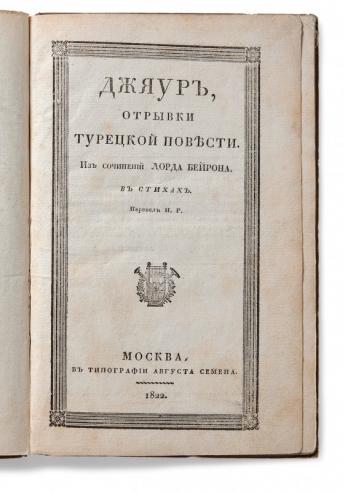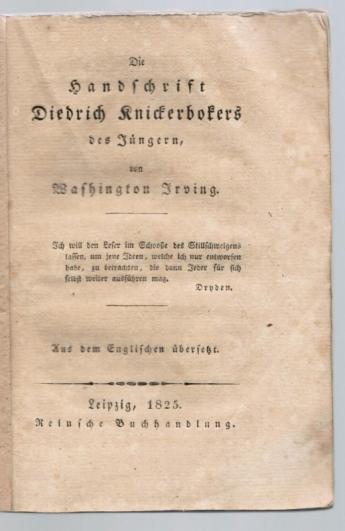Antiquarian Booksellers' Association Simon Beattie Ltd
Collecting Rare Books and First Editions - Byron in Russia. Washington Irving in Germany

By Simon Beattie
‘Of all the countries which came under the spell of Byron’s pen and pageantry in the first half of the nineteenth century, none was more deeply entranced than Russia … Certainly there was hardly a Russian poet in the romantic period who was not directly or indirectly influenced by Byron’s life and verse. His name became synonymous with “romantic,” and he was regarded as the “leading mind” of the age. Of contemporary figures only Goethe could compete with him in renown, and certain liberty-loving Russians ranked the Englishman above the great German’ (Simmons, English Literature and Culture in Russia (1553–1840), pp. 269–70).
The first Russian translations of Byron appeared in 1820, in journals such as Syn Otechestva and Vestnik Evropy. This is The Giaour (1813), translated - in verse - by Nikolai Radishchev (son of the famous eighteenth-century writer), only the second separate appearance of anything by Byron in Russian. The first was The Prisoner of Chillon, published in St Petersburg the month before (Shil’onskii uznik, tr. Zhukovsky).
Washington Irving’s name and fame reached Germany suddenly when in 1819–20 The Sketch Book of Geoffrey Crayon, Gent. was published in England and America. Diedrich Knickerbocker’s History of New York (1809), which had appeared ten years earlier and had established Irving’s reputation as a writer, held no appeal for Europe. Its native satire and its mockery of American politics were incomprehensible to those not intimately acquainted with New York life and its political scene. But when British journals began to praise this first American man of letters and reprinted authorized or pirated sections from The Sketch Book, German papers and periodicals promptly translated these extracts. Editions in book form quickly followed, and the reception was enthusiastic.
This, the first German collection of Irving’s tales (or Irwing’s!), appeared in Dresden in 1822, comprising ‘The Wife’, ‘The Legend of Sleepy Hollow’, ‘The Widow and her Son’, ‘Rip Van Winkle’, and ‘The Spectre Bridegroom’. An American man of letters such as Irving was a European novelty, but he was soon hailed as a new star upon the literary horizon, perhaps the herald of a new constellation in the New World. For more than fifty years Irving was not only read widely in Germany, but his work actually influenced the writings of many German authors. The younger generation of German writers came in their formative years under the spell of Irving’s narratives so that his literary and stylistic manner is reflected (and in many cases acknowledged) in the works of Hauff, Heine, Droste-Hülshoff, etc. See Walter A. Reichardt, ‘Washington Irving’s influence in German literature’, Modern Language Review, vol. 52, no. 4 (October 1957).
(Published in part 1 and part 2 on The Books You Never Knew You Wanted. Presented here by permission of the author.)
Are you looking for rare and fine books and autographs by
>>> Byron?
>>> Washington Irving?
Click the above links and browse the ILAB Metasearch.

